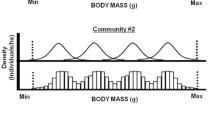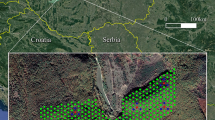Abstract
The composition and structure of bird communities, and the damage to forest structure were surveyed in northern French Guiana (northeastern Amazonia) one year and ten years after selective logging and compared with the situation in a similar undisturbed primary forest. A point-count method was used in which 937 0.25ha sample plots were censused for 20 minutes each, and their vegetation structure was measured. On average, 38% of the forest undergrowth was destroyed, then invaded by dense regrowth, and up to 63% of the canopy was substantially opened as a result of selective logging. Hunting pressure also increased due to access roads opened for logging. Among the 256 species recorded, overall bird species richness and abundance were depressed by 27–34% in the logged areas compared to primary forest. The most vulnerable guilds, which decreased by 37–98% in abundance, were mature forest understorey species, especially terrestrial ones and mixed flocks of insectivores. Hummingbirds, small gaps, vine tangles and canopy species did not decrease, nor increase significantly after logging. Only species naturally associated with dense second growth, forest edges and large gaps actually increased. Habitat specialization was the major determinant of vulnerability to logging, and, to a lesser degree, size (large) and diet (insectivorous), but foraging behaviour and rarity had little effect. Bird sensitivity to changes in logged forest structure may involve physiological intolerance, reduced food categories, increased exposure to predators, too dense understorey for their specific foraging behaviour and/or avoidance of gaps. Suggested improvements of current forest management and logging techniques for the maintenance of a higher proportion of the original biodiversity include minimizing logging damages, long rotations (>50 years) between cuts, and keeping unlogged forest patches within logging concessions.
Similar content being viewed by others
References
Abugov, R. (1982) Species diversity and phasing of disturbance. Ecology 63, 289–93.
Adams, D.L. and Barrett, G.W. (1976) Stress effect on bird species diversity within mature forest ecosystems. American Middland Naturalist 96, 179–94.
Bennett, E.L. and Dahaban, Z. (1995) Wildlife responses to disturbances in Sarawak and their implications for forest management. In Ecology, Conservation and Management of Southeast Asian Rain Forests (R.B. Primack and T.E. Lovejoy, eds) pp. 66–86. NewHaven: Yale University Press.
Buckley, R. (1983) A possible mechanism for maintaining diversity in species-rich communities: an addendum to Connell's hypotheses. Oikos 40, 312.
Burgess, P.F. (1971) The effect of logging on hill Dipterocarp forests. Malay Nature Journal 24, 231–37.
Connell, J.H. (1978) Diversity in tropical rain forests and coral reefs. Science 19, 1302–10.
CTFT (Centre Technique Forestier Tropical) (1990) Aménagement des écosystèmes forestiers tropicaux. Proceedings French Guiana, Cayenne: Atelier MAB-FAO.
Denslow, J.S. (1987) Tropical rain forest gaps and tree species diversity. Ann. Rev. Ecol. Syst. 18, 31–451.
Driscoll, P.V. and Kikkawa, J. (1989) Bird species diversity of lowland tropical rain forests of New Guinea and Northern Australia. In Vertebrates in complex tropical systems (M. Harmelin-Vivien and F. Bourlière, eds) pp. 123–52. New York: Springer Verlag.
Feinsinger, P., Busby, W.H., Murray, K.G., Beach, J.M., Pounds, W.Z. and Linhart, Y.B. (1988) Mixed support for spatial heterogeneity in species interactions: hummingbirds in a tropical disturbance mosaic. Amer. Natural. 131, 33–57.
Heck, K.K., Vanbelle, G. and Simberloff, D.S. (1975) Explicit calculation of the rarefaction diversity measurement and the determination of sufficient sample size. Ecology 56, 1459–61.
Hill, J.K., Hamer, K.C., Lace, L.A. and Banham, W.M. (1995) Effects of selective logging on tropical forest butterflies on Buru, Indonesia. J. Appl. Ecol. 32, 754–60.
Hutto, R.L., Pletschet, S.M. and Hendricks, P. (1986) A fixed-radius point count method for non breeding and breeding season use. The Auk 103, 593–602.
Johns, A.D. (1985) Selective logging and wildlife conservation in tropical rain forest: problems and recommendations. Biol. Conserv. 31, 355–375.
Johns, A.D. (1986) Effects of selective logging on the ecological organization of a peninsular malaysian rain forest avifauna. Forktail 1, 65–79.
Johns, A.D. (1988) Effects of “selective” timber extraction on rain forest structure and composition and some consequences for frugivores and folivores. Biotropica 20, 31–6.
Johns, A.D. (1989) Recovery of a Peninsular Malaysian rain forest avifauna following selective timber logging: the first twelve years. Forktail 64, 1481–94.
Johns, A.D. (1991) Responses of amazonian rain forest birds to habitat modification. J. Trop. Ecol. 7, 417–37.
Johns, A.D. (1992) Species conservation in managed tropical forests. In Tropical deforestation and species extinction (T.C. Whitmore and J.A. Sayer, eds) pp. 15–53. London: Chapman and Hall and IUCN.
Johns, A.D. (1996) Bird population persistence in Sabahan logging concessions. Biol. Conserv. 75, 3–10.
Jullien, M. and Thiollay, J.M. (1996) Effects of rain forest disturbance and fragmentation: comparative changes of the raptor community along natural and man-made gradients in French Guiana. Journal of Biogeography 23, 7–25.
Jullien, M. and Thiollay, J.M. (in press) Multispecies territoriality in neotropical understorey bird flocks: a general phenomenon? J. Anim. Ecol.
Lambert, F.R. (1992) The consequences of selective logging for Bornean lowland forest birds. Phil. Trans. R. Soc. Lond. B. 335, 443.
Nicholson, D.T. (1958) An analysis of logging damage in tropical rainforest, North Borneo. Malaysian Forestry 21, 235–45.
Rappole, J.H. and Morton, E.S. (1985) Effects of habitat alteration on a tropical avian forest community. In Neotropical ornithology (P.A. Buckley et al., eds) pp. 1013–21. Washington DC, AOU, American Ornithologists' Union Monographs No 36.
Riera, B. and Alexandre, D.Y. (1988) Surface des chablis et temps de renouvellement en forêt dense tropicale. Acta Oecol. 57, 773–82.
Schemske, D.W. and Brokaw, N. (1981) Treefalls, and the distribution of understorey birds in a tropical forest. Ecology 62, 938–45.
Schmitt, L. and Bariteau, M. (1990) Gestion de l'écosystème forestier guyanais. Etude de la croissance et de la régénération naturelle. Dispositif de Paracou. Bois et Forêts des Tropiques 220, 3–23.
Stouffer, P.C. and Bierregaard, R.O. (1995a) Effects of forest fragmentation on understorey hummingbirds in Amazonian Brazil. Conserv. Biol. 9, 1085–94.
Stouffer, P.C. and Bierregaard, R.O. (1995b) Use of amazonian forest fragments by understorey insectivorous birds. Ecology 76, 2429–45.
Thiollay, J.M. (1985a) Composition of Falconiforms communities along successional gradients from primary rain forest to secondary habitats. In Conservation studies of raptors (I. Newton and R. Chancellor, eds) pp. 181–90. Cambridge, International Council for Bird Preservation, ICBP Technical Publication No 5.
Thiollay, J.M. (1985b) Raptor community structure of a primary rain forest in French Guiana and effect of human hunting pressure. Raptor Research 18, 117–22.
Thiollay, J.M. (1985c) Birds of prey in French Guiana. A preliminary survey. Bulletin of the World Working Group on Birds of Prey 2, 11–15.
Thiollay, J.M. (1989a) Area requirements for the conservation of rain forest raptors and game birds in French Guiana. Conserv. Biol. 3, 128–37.
Thiollay, J.M. (1989b) Censusing of diurnal raptors in a primary rainforest: comparative methods and species detectability. Journal of Raptor Research 23, 72–84.
Thiollay, J.M. (1990) Comparative diversity of temperate and tropical forest bird communities: the influence of habitat heterogeneity. Acta Oecol. 11, 887–911.
Thiollay, J.M. (1992) Influence of selective logging on bird species diversity in a guianan rain forest. Conserv. Biol. 6, 47–63.
Thiollay, J.M. (1994) Structure, density and rarity in an Amazonian rain forest bird community. J. Trop. Ecol. 10, 449–81.
Tostain, O., Dujardin, J.L., Erard, C. and Thiollay, J.M. (1992) Oiseaux de Guyane. Société d'Etudes Ornithologiques, Brunoy.
Uhl, Ch. and Guimaraes Viera, I.C. (1989) Ecological impacts of selective logging in the Brazilian Amazon: a case study from the Paragominas region in the state of Para. Biotropica 21, 98–106.
Webb, W.L., Behrend, D.F. and Saisorn, B. (1977) Effect of logging on song bird populations in a northern hardwood forest. Wildlife Monographs 55, 1–35.
Whitcomb, B.R., Whitcomb, R.S. and Bystrak, D. (1977) Long-term turnover and effects of selective logging on the avifauna. American Birds 31, 17–23.
Whitmore, T.C. (1980) The conservation of tropical rain forest. In Conservation Biology (M.E. Soulé and B. Wilcox, eds) pp. 303–318. Sunderland, Massachussetts: Sinauer.
Wunderle, J.M., Diaz, A., Velasquez, I. and Sharron, R. (1987) Forest openings and the distribution of understorey birds in a Puerto Rican rain forest. The Wilson Bulletin 99, 22–37.
Wyatt-Smith, J. and Foenander, E.C. (1962) Damage to regeneration as a result of logging. Malaysian Forestry 25, 40–4.
Author information
Authors and Affiliations
Rights and permissions
About this article
Cite this article
THIOLLAY, JM. Disturbance, selective logging and bird diversity: a Neotropical forest study. Biodiversity and Conservation 6, 1155–1173 (1997). https://doi.org/10.1023/A:1018388202698
Issue Date:
DOI: https://doi.org/10.1023/A:1018388202698




